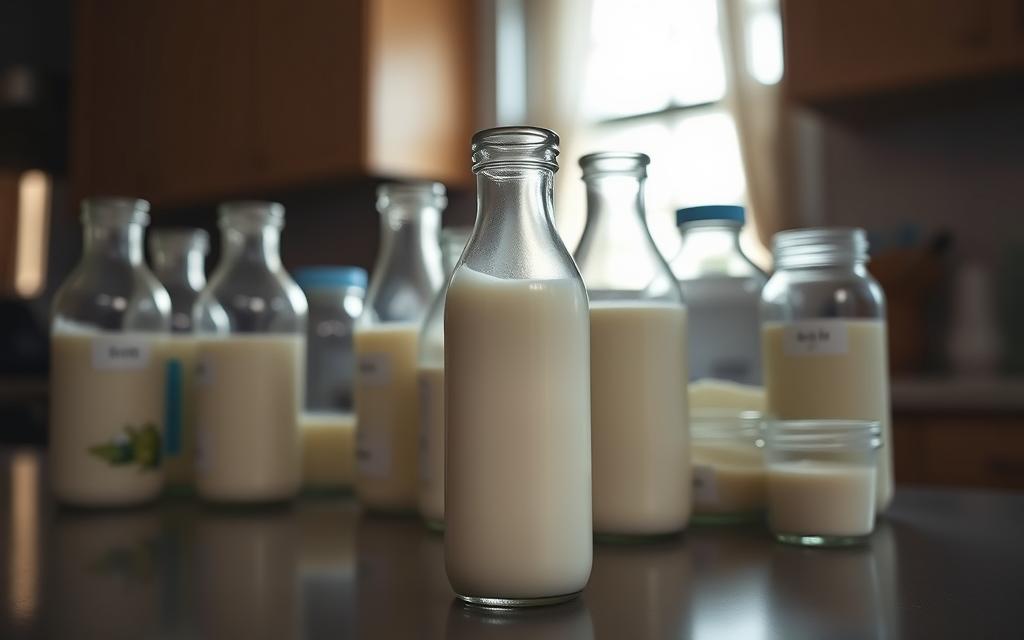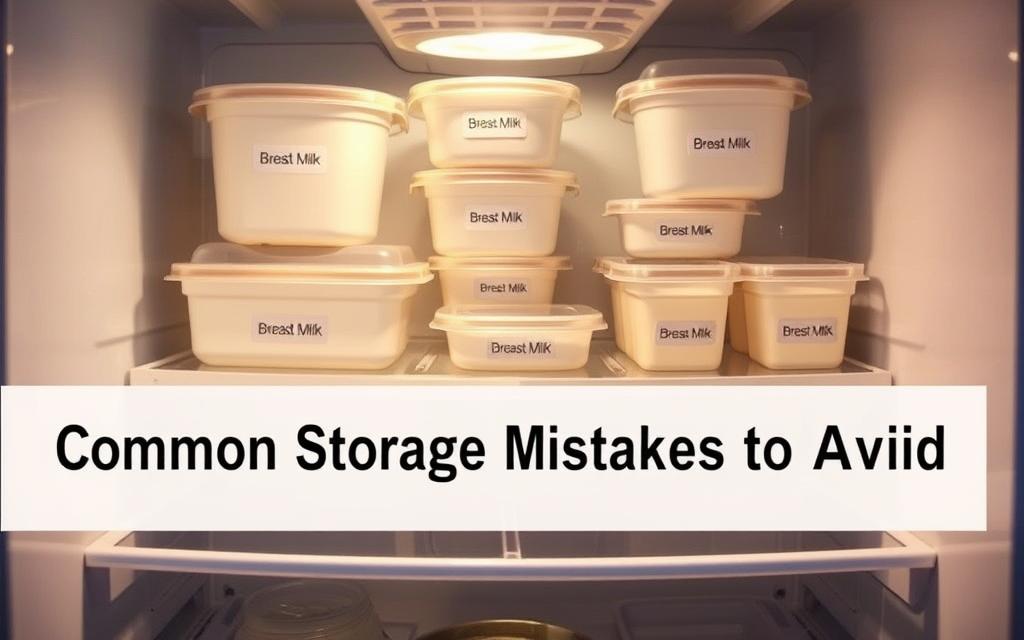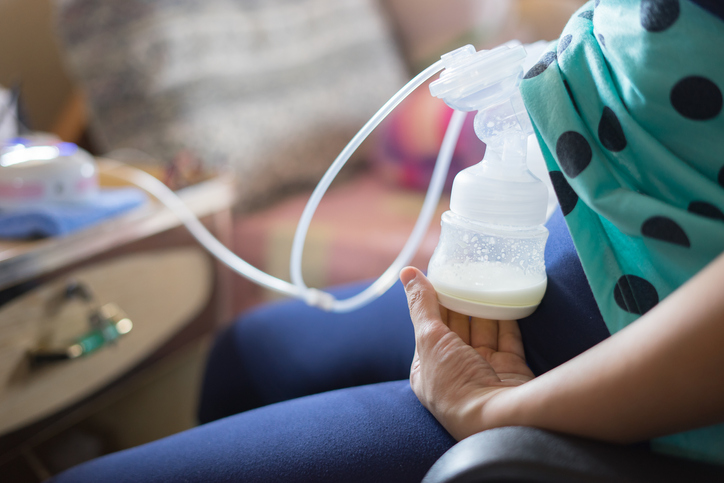How Long Can Breast Milk Be Safely Stored?

Storing breast milk properly is key to keeping it safe and good quality. The Mayo Clinic says you can store it in a deep freezer for up to 6 months. In the fridge, it’s safe for 4 days. Knowing how to store breast milk is vital for its safety.
Storing breast milk right helps keep its nutrients and prevents contamination. This is why following certain guidelines is important.
It’s important to follow the right steps to keep breast milk safe. You can store it at room temperature, in the fridge, or freezer. Each method has its own rules. By sticking to these, mothers can keep their milk safe and healthy for their babies.
Understanding how to store breast milk is essential. It helps ensure the milk stays safe and good for your baby. So, knowing the guidelines is key for keeping your milk in top condition.
Key Takeaways
- Breast milk can be stored safely for up to 6 months in a deep freezer
- Breast milk can be stored in the refrigerator for up to 4 days
- Proper breast milk storage involves following specific guidelines
- Breast milk storage guidelines vary depending on the storage method
- Understanding breast milk guidelines is essential for ensuring breast milk safety
- Proper breast milk storage is critical for maintaining breast milk quality and safety
- Mothers should follow proper breast milk storage guidelines to ensure their breast milk remains safe and healthy for their babies
Understanding Breast Milk Storage Basics
Proper handling and storage of breast milk are key to keeping it safe and of high quality. It’s important to follow guidelines to ensure the milk stays good for your baby. This includes keeping the right temperature and using clean containers.
Before you start, make sure to wash your hands well. This simple step helps prevent contamination and keeps the milk safe. Also, use only clean, food-grade containers to keep the milk quality up.
Why Proper Storage Matters
Storing breast milk right is vital for its nutritional value and safety. Guidelines suggest keeping it in the fridge or freezer’s back to keep it cool. This stops bacteria and other harmful germs from growing.
Components of Breast Milk
Breast milk is full of nutrients like proteins, fats, and vitamins. Its makeup can change based on the mom’s diet and the baby’s age. Knowing what’s in breast milk helps with how to handle and store it.
General Storage Rules
General rules for storing breast milk include using a clean, sealed container. Keep it at a steady fridge or freezer temperature. Also, mark the container with the date and time you expressed it. This makes it easy to use the oldest milk first.
By following these tips and being careful with how you handle and store breast milk, moms can keep it safe and nutritious for their babies.
Breast Milk Storage Guidelines: How Long Is It Safe?
Keeping breast milk safe is key. The Mayo Clinic says you can store it in a deep freezer for up to 6 months. In the fridge, it’s good for 4 days. Always follow the right breast milk guidelines for storage.
Fresh milk can stay at room temperature for 4 hours. In the fridge, it lasts 4 days. Freezing is best for longer storage. You can freeze it for 9 months in a fridge freezer and up to 12 months in a deep freezer.
- Store breast milk in small batches of 2-4 ounces
- Leave about an inch of space at the top of the container to accommodate expansion
- Use the oldest milk first, following a first in, first out (FIFO) practice for storage
By sticking to these breast milk guidelines, you keep your milk safe and nutritious. This ensures your baby gets the best nutrition.
Room Temperature Storage Methods
Storing breast milk at room temperature needs careful steps to keep it safe and good quality. It’s important to handle and store breast milk correctly to avoid contamination and spoilage. Studies show that breast milk can stay safe at room temperature for up to 4 hours. But, it’s best to use it within 2 hours for the best quality.
Choosing the right container is key for safe storage. Use a clean, airtight container and label it with the date and time. Always check for signs of spoilage like an off smell or slimy texture. If you see these, throw out the milk to keep it safe.
Here are some tips for handling and storing breast milk at room temperature:
- Store breast milk in a clean, airtight container
- Label the container with the date and time it was expressed
- Check for signs of spoilage before using the milk
- Discard breast milk that has been stored at room temperature for more than 4 hours
By following these tips, you can keep your breast milk safe and of good quality. Whether you’re storing it at room temperature, in the fridge, or freezer, safety is the top priority. Proper handling and storage prevent contamination and spoilage.
Refrigeration Storage Guidelines
Storing breast milk in the fridge is key to keeping it safe. The Mayo Clinic says you can store it for up to 4 days. It’s important to use a clean, airtight container and keep it cold, below 40°F (4°C).
Here are some tips for storing breast milk in the fridge:
- Store it in the back of the fridge for a steady temperature.
- Choose a BPA-free container made for breast milk storage.
- Mark the container with the date, time, and amount of milk.
By following these guidelines, you keep your milk safe and healthy for your baby. Always check the milk for spoilage before feeding it. If it smells bad or looks off, throw it away.
For more on breast milk safety and storage, talk to your healthcare provider or a lactation consultant. They can offer personalized advice and support for expressing and storing milk.
Freezer Storage Techniques
Proper storage of breast milk in the freezer is key to keeping it safe. You can store breast milk in the freezer for up to 6 months. If the milk is very clean, it can last up to 9 months. Always store it in the back of the freezer to avoid temperature changes.
Here are some tips for storing breast milk in the freezer:
- Store milk in small portions, less than 60 ml, to minimize wastage and make thawing easier.
- Do not fill bottles or bags more than three-quarters full, as breast milk expands during freezing.
- Label and date each container, and store them in a way that allows for easy rotation, following a “first in, first out” approach.
Freezing breast milk correctly is important for its safety. Store it in a deep freezer at -18°C (0°F) or colder. If you only have a regular freezer, the storage time will be shorter.
When thawing frozen breast milk, follow these guidelines. Thawed breast milk can be stored in the fridge for up to 24 hours. Use it within that time. Never re-freeze thawed breast milk, as it can lose quality and safety.
| Storage Method | Storage Time |
|---|---|
| Freezer (-18°C / 0°F or colder) | Up to 6 months |
| Refrigerator (4°C / 39°F or colder) | Up to 3 days |
| Room Temperature (16°C to 25°C / 60°F to 77°F) | Up to 4 hours |
Best Practices for Storing Pumped Milk
Keeping breast milk safe and fresh is very important. The Mayo Clinic says you can store it in a deep freezer for up to 6 months. In the fridge, it’s good for up to 4 days. Knowing how to store pumped milk right is key.
Keeping things clean is the first step in handling breast milk. Always wash your hands before you start. Use a clean container and label it with the date and time.
- Store breast milk in small amounts, such as 2 to 4 ounces, to minimize waste.
- Use a cool bag with ice packs to transport breast milk for up to 24 hours.
- Once defrosted, breast milk should be used immediately and should not be re-frozen.
By following these tips, you can keep your breast milk safe and nutritious for your baby. Always focus on keeping the milk safe and fresh.
Transport and Travel Storage Solutions
When it comes to breast milk transportation, safety and guidelines are key. The Academy of Breastfeeding Medicine says milk can stay good in a cooler with ice packs for up to 24 hours. It’s vital to follow breast milk guidelines to keep the milk safe and of high quality.
Working moms face a challenge in storing breast milk at work. But, with the right containers and cooling methods, it’s doable. It’s best to use BPA-free bottles or bags for breast milk storage. Also, labeling the milk with the date and time it was pumped is important.
Some important tips for breast milk transportation and travel storage are:
- Using an insulated cooler bag with frozen ice packs
- Storing breast milk in small amounts of 2 to 4 ounces to avoid waste
- Following TSA guidelines for carrying breast milk in carry-on luggage
- Labeling breast milk with the date and time it was pumped
By following these breast milk guidelines and taking the right steps, mothers can keep their breast milk safe. This is true whether at work or while traveling. Always put breast milk safety first to keep the milk quality and integrity.
Common Storage Mistakes to Avoid
Keeping breast milk safe is key. To keep it nutritious, follow important guidelines. One major rule is to keep it cold. It should stay below 40°F to stop bacteria and keep its good stuff.
Choosing the right container is also vital. Use clean, safe containers to avoid contamination. Always label and date them so you use the oldest first. 
Here are some mistakes to steer clear of:
- Not washing hands before handling breast milk
- Using contaminated or unclean containers
- Not labeling or dating the containers
- Storing breast milk at inconsistent temperatures
By sticking to safety tips and avoiding these errors, moms can keep their milk safe and healthy. Good handling and storage are essential. They help keep the milk’s quality and nutrients for the baby.
Conclusion: Ensuring Safe Breast Milk Storage
As we finish talking about breast milk storage, it’s key to remember the importance of following guidelines. This ensures the safety and quality of your breast milk. Proper storage helps keep the nutrients in and stops harmful bacteria from growing.
The Mayo Clinic says you can store freshly expressed breast milk at room temperature (77°F or colder) for up to 4 hours. For longer storage, you can refrigerate it for up to 4 days or freeze it for 6-12 months in a deep freezer. Thawed breast milk should be used within 24 hours and not refrozen. By sticking to these guidelines, you keep your breast milk safe and good for your baby.






